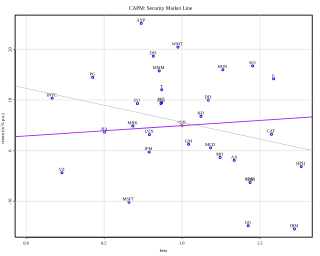Related Research Articles
Finance is the study and discipline of money, currency and capital assets. It is related to, but not synonymous with economics, which is the study of production, distribution, and consumption of goods and services; the discipline of financial economics bridges the two. Financial activities take place in financial systems at various scopes; thus, the field can be roughly divided into personal, corporate, and public finance.
Financial economics is the branch of economics characterized by a "concentration on monetary activities", in which "money of one type or another is likely to appear on both sides of a trade". Its concern is thus the interrelation of financial variables, such as share prices, interest rates and exchange rates, as opposed to those concerning the real economy. It has two main areas of focus: asset pricing and corporate finance; the first being the perspective of providers of capital, i.e. investors, and the second of users of capital. It thus provides the theoretical underpinning for much of finance.
This aims to be a complete article list of economics topics:

Fischer Sheffey Black was an American economist, best known as one of the authors of the Black–Scholes equation.

Myron Samuel Scholes is a Canadian–American financial economist. Scholes is the Frank E. Buck Professor of Finance, Emeritus, at the Stanford Graduate School of Business, Nobel Laureate in Economic Sciences, and co-originator of the Black–Scholes options pricing model. Scholes is currently the chairman of the Board of Economic Advisers of Stamos Capital Partners. Previously he served as the chairman of Platinum Grove Asset Management and on the Dimensional Fund Advisors board of directors, American Century Mutual Fund board of directors and the Cutwater Advisory Board. He was a principal and limited partner at Long-Term Capital Management (LTCM), a highly leveraged hedge fund that collapsed in 1998, and a managing director at Salomon Brothers. Other positions Scholes held include the Edward Eagle Brown Professor of Finance at the University of Chicago, senior research fellow at the Hoover Institution, director of the Center for Research in Security Prices, and professor of finance at MIT's Sloan School of Management. Scholes earned his PhD at the University of Chicago.

In finance, the capital asset pricing model (CAPM) is a model used to determine a theoretically appropriate required rate of return of an asset, to make decisions about adding assets to a well-diversified portfolio.

Investment banking pertains to certain activities of a financial services company or a corporate division that consist in advisory-based financial transactions on behalf of individuals, corporations, and governments. Traditionally associated with corporate finance, such a bank might assist in raising financial capital by underwriting or acting as the client's agent in the issuance of debt or equity securities. An investment bank may also assist companies involved in mergers and acquisitions (M&A) and provide ancillary services such as market making, trading of derivatives and equity securities, FICC services or research. Most investment banks maintain prime brokerage and asset management departments in conjunction with their investment research businesses. As an industry, it is broken up into the Bulge Bracket, Middle Market, and boutique market.
Financial risk management is the practice of protecting economic value in a firm by managing exposure to financial risk - principally operational risk, credit risk and market risk, with more specific variants as listed aside. As for risk management more generally, financial risk management requires identifying the sources of risk, measuring these, and crafting plans to address them. See Finance § Risk management for an overview.
Investment management is the professional asset management of various securities, including shareholdings, bonds, and other assets, such as real estate, to meet specified investment goals for the benefit of investors. Investors may be institutions, such as insurance companies, pension funds, corporations, charities, educational establishments, or private investors, either directly via investment contracts/mandates or via collective investment schemes like mutual funds, exchange-traded funds, or REITs.
Active management is an approach to investing. In an actively managed portfolio of investments, the investor selects the investments that make up the portfolio. Active management is often compared to passive management or index investing.
In financial economics, asset pricing refers to a formal treatment and development of two main pricing principles, outlined below, together with the resultant models. There have been many models developed for different situations, but correspondingly, these stem from either general equilibrium asset pricing or rational asset pricing, the latter corresponding to risk neutral pricing.
The following outline is provided as an overview of and topical guide to finance:
Amaranth Advisors LLC was an American multi-strategy hedge fund founded by Nicholas M. Maounis and headquartered in Greenwich, Connecticut. At its peak, the firm had up to $9.2 billion in assets under management before collapsing in September 2006, after losing in excess of $6 billion on natural gas futures. Amaranth Advisors collapse is one of the biggest hedge fund collapses in history and at the time (2006) largest known trading losses.
In finance, the Black–Litterman model is a mathematical model for portfolio allocation developed in 1990 at Goldman Sachs by Fischer Black and Robert Litterman, and published in 1992. It seeks to overcome problems that institutional investors have encountered in applying modern portfolio theory in practice. The model starts with an asset allocation based on the equilibrium assumption and then modifies that allocation by taking into account the opinion of the investor regarding future asset performance.
Clifford Scott Asness is an American hedge fund manager and the co-founder of AQR Capital Management. According to an April 2020 Forbes profile, Asness' estimated net worth was $2.6 billion.
Quantitative analysis is the use of mathematical and statistical methods in finance and investment management. Those working in the field are quantitative analysts (quants). Quants tend to specialize in specific areas which may include derivative structuring or pricing, risk management, investment management and other related finance occupations. The occupation is similar to those in industrial mathematics in other industries. The process usually consists of searching vast databases for patterns, such as correlations among liquid assets or price-movement patterns.
Goldman Sachs asset management (GSAM) factor model is one of the quantitative/ factor models used by financial analysts to assess the performance and financial condition of a company. Typically quantitative models are based on inputs obtained from financial statements(FS). There are various types of factor models – statistical models, macroeconomic models and fundamental models. A fundamental factor model uses company and industry attributes and market data known as "factors" to explain a company's historical returns. Since the input factors from FS may be questionable or the data may not be comparable over time this model includes a factor that is based on an assessment by equity analysts performing traditional equity analysis.
Downside risk is the financial risk associated with losses. That is, it is the risk of the actual return being below the expected return, or the uncertainty about the magnitude of that difference.

In investing and finance, the low-volatility anomaly is the observation that low-volatility stocks have higher returns than high-volatility stocks in most markets studied. This is an example of a stock market anomaly since it contradicts the central prediction of many financial theories that taking higher risk must be compensated with higher returns.
In finance, active return refers the returns produced by an investment portfolio due to active management decisions made by the portfolio manager that cannot be explained by the portfolio's exposure to returns or to risks in the portfolio's investment benchmark; active return is usually the objective of active management and subject of performance attribution. In contrast, passive returns refers to returns produced by an investment portfolio due to its exposure to returns of its benchmark. Passive returns can be obtained deliberately through passive tracking of the portfolio benchmark or obtained inadvertently through an investment process unrelated to tracking the index.
References
- 1 2 Roston, Eric (November 3, 2017). "There's One Unspeakable Fix That Would Help Pay for the GOP's Tax Cuts". Bloomberg.com.
- 1 2 3 Mehrling, Perry; Brown, Aaron (December 2011). Fischer Black and the Revolutionary Idea of Finance. Wiley.
- ↑ Djanga, Emmanuel (January 11, 2017). "The Black Litterman Model: Investment Theory Versus Market Reality | The Market Mogul". themarketmogul.com.
- ↑ Litterman, Bob; Quantitative Resources Group (2004). Modern Investment Management: An Equilibrium Approach. John Wiley & Sons. ISBN 9780471480655.
- ↑ Craig, Susanne; Protess, Ben; Rusli, Evelyn M. (16 May 2011). "The Goldman Sachs Diaspora". DealBook.
- ↑ "Leadership". Woodwell Climate. Retrieved 2022-09-13.
- ↑ "Robert Litterman | Climate Central". www.climatecentral.org.
- ↑ "Robert Litterman | Leaders | WWF". World Wildlife Fund. Retrieved 19 December 2017.
- ↑ Strauss, Karsten (29 November 2017). "Business Leaders Explore A Path Toward A Carbon Tax". Forbes.
- ↑ Daniel, Kent D.; Litterman, Robert B.; Wagner, Gernot (15 October 2019). "Declining CO2 price paths". Proceedings of the National Academy of Sciences. 116 (42): 20886–20891. doi: 10.1073/pnas.1817444116 . ISSN 0027-8424. PMC 6800385 . PMID 31575747.
- ↑ "Climate-Related Market Risk Subcommittee | CFTC". www.cftc.gov.
- ↑ Saphir, Ann (12 June 2020). "U.S. Regulator to report on climate risks to markets in July". Reuters.